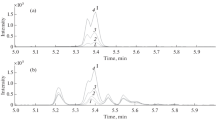Summary
In order to collect urinary samples from unrestrained guinea pigs, animals were kept in their familiar home cages with wood shavings for bedding. Cortisol was removed from shavings by a simple washing step, and an attempt was made to measure its concentrations by high performance thin-layer chromatography (HPTLC), high performance liquid chromatography (HPLC), or thin layer chromatography/radioimmunoassay (TLC-RIA). After intramuscular administration of 25 mg cortisol, cortisol excretion increased from about 20–30 μg/day to 400–500 μg/day (HPTLC: 531 μg/day, HPLC: 493 μg/day; TLC-RIA: 394 μg/day). Similarly, the treatment of the animals with 20 IU ACTH resulted in an augmented cortisol excretion, with mean values of 294 μg/day (HPTLC), 256 μg/day (HPLC) and 143 μg/day (TLC-RIA), respectively.
The present study shows, for the first time, that cortisol excretion in unrestrained laboratory animals can be determined. Whilst the cortisol values measured by HPTLC and HPLC agree, the amounts measured by TLC-RIA were significantly lower. These differences are probably due to the presence of substances in urine or shavings which interfere with the radioimmunological determination. Hence, cortisol should be determined either by HPTLC or HPLC. Beside having a desirable specificity, these methods are more suited than TLC/RIA for steroid analysis since they confer the possibility of measuring additional steroids (e.g. precursors and/or metabolites of cortisol) in a single urine extract. This is especially the case for the HPTLC method since substances can be transformed into fluorescent derivatives.
Similar content being viewed by others
References
S. Burstein, B. R. Bhavnani, H. L. Kimball, Endocrinology76, 753 (1965).
W. H. Huibregtse, Am J Physiol214, 1268 (1968).
H.K. Kley, W. Elasser, H. Dehnen, H. L. Kruskemper, Steroids32, 223 (1978).
M. Fenske, Comp. Biochem. Physiol.88A, 153 (1988).
M. Fenske, Zool. Jb. (Physiol)96, 435 (1992).
M. Fenske, Anal. Biochem.231, 447 (1995).
B. Belanger, J. Couture, S. Caron, P. Bodou, J. Fiet, A. Belanger, Steroids55, 360 (1990).
M. Fenske, Chromatographia41, 175 (1995).
M. Schoneshöfer, A. Fenner, H. J. Dulce, Clin. Chim. Acta101, 125 (1980).
H. W. Mueller, J. Eitel, J. Chromat. B,678, 137 (1996).
R. Klaus, W. Fischer, H. E. Hauck, Chromatographia39, 97 (1994).
H. Jork, W. Funk, W. Fischer, H. Wimmer, “Thin-Layer Chromatography Reagents and Detection Methods,” VCH, Weinheim/New York/Basel/Cambridge/ Tokyo, 1994, Vol. 1b, p. 402ff.
Author information
Authors and Affiliations
Rights and permissions
About this article
Cite this article
Fenske, M. Determination of cortisol in guinea pig urine by high performance thin-layer chromatography, high performance liquid chromatography, and thin-layer chromatography/radioimmunoassay. Chromatographia 44, 50–54 (1997). https://doi.org/10.1007/BF02466515
Received:
Revised:
Accepted:
Issue Date:
DOI: https://doi.org/10.1007/BF02466515




